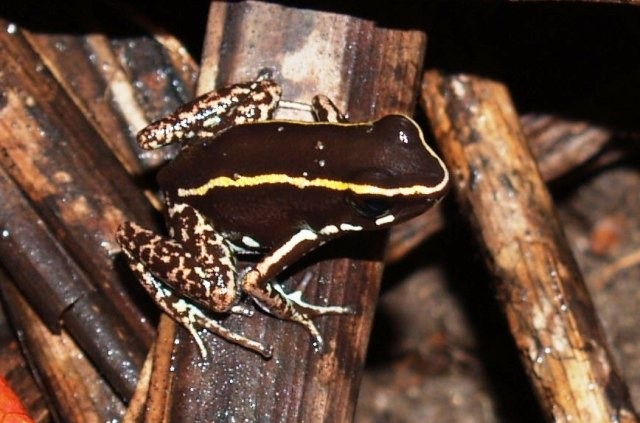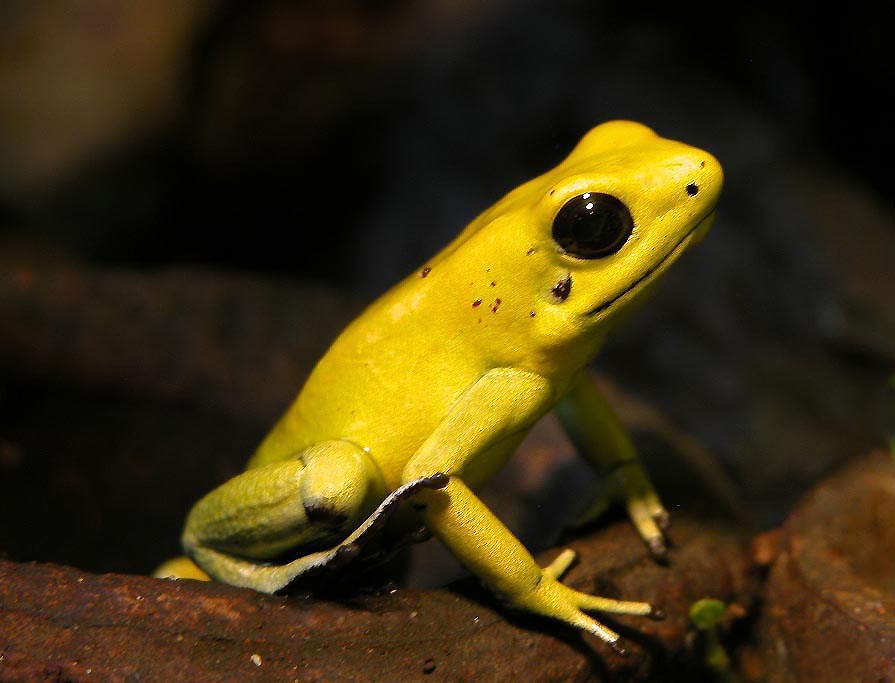|
Phyllobates
''Phyllobates'' is a genus of poison dart frogs native to Central and South America, from Nicaragua to Colombia. There are 3 different Colombian species of ''Phyllobates'', considered highly toxic species due to the poison they contain in the wild. ''Phyllobates'' contains the most poisonous species of frog, the golden poison frog (''P. terribilis''). They are typical of the poison dart frogs, in that all species have bright warning coloration (aposematism), and have varying degrees of toxicity. Only species of ''Phyllobates'' are used by natives of South American tribes as sources of poison for their hunting darts. The most toxic of the many poisonous alkaloids these frogs contain (in glands in their skin) is batrachotoxin, alongside a wide variety of other toxic compounds. Some populations of '' Phyllobates lugubris'' in Central America are not known to be toxic. Taxonomy ''Phyllobates'' (Ancient Greek for "leaf climber") used to contain many of the species which are now wit ... [...More Info...] [...Related Items...] OR: [Wikipedia] [Google] [Baidu] |
Golden Poison Frog
The golden poison frog (''Phyllobates terribilis''), also known as the golden dart frog or golden poison arrow frog, is a poison dart frog endemic to the rainforests of Colombia. The golden poison frog has become endangered due to habitat destruction within its naturally limited range. Despite its small size, this frog is likely the most poisonous animal on the planet. Taxonomy and etymology The golden poison frog was described as ''Phyllobates terribilis'' in 1978 by herpetologists Charles W. Myers and Borys Malkin as well as biochemist John W. Daly; the species name ''terribilis'' is a reference to the deadly toxins present in the skin secretions of this species. Myers' research was based on hundreds of specimens collected on an expedition to the Quebrada Guangui and La Brea regions of the Colombian rainforest, and a breeding colony of 18 frogs established at the American Museum of Natural History. Distribution and habitat The golden poison frog is endemic to humid forest ... [...More Info...] [...Related Items...] OR: [Wikipedia] [Google] [Baidu] |
Phyllobates Bicolor
''Phyllobates bicolor'', or more commonly referred to as the black-legged poison dart frog, is the world's second-most toxic dart frog. Under the genus ''Phyllobates'', this organism is often mistaken as '' Phyllobates terribilis'', the golden poison frog, as both are morphologically similar. However, ''Phyllobates'' ''bicolor'' is identifiable by the yellow or orange body and black or dark blue forelimbs and hindlegs, hence the name black-legged dart frog. ''Phyllobates bicolor'' are commonly found in tropical forests of the Chocó region of Colombia. The diurnal frogs live along the rainforest ground near streams or puddles that form. Notably, ''P. bicolor'' is a member of the family ''Dendrobatidae'', or poison dart frog. ''P. bicolor,'' along with the rest of the ''Phyllobates'' species, produce a neurotoxin known as a batrachotoxin that inhibits specific transmembrane channels in cells. Due to this highly deadly toxin that the frogs secrete, many indigenous groups of the Colombi ... [...More Info...] [...Related Items...] OR: [Wikipedia] [Google] [Baidu] |
Phyllobates Sp
''Phyllobates'' is a genus of poison dart frogs native to Central and South America, from Nicaragua to Colombia. There are 3 different Colombian species of ''Phyllobates'', considered highly toxic species due to the poison they contain in the wild. ''Phyllobates'' contains the most poisonous species of frog, the golden poison frog (''P. terribilis''). They are typical of the poison dart frogs, in that all species have bright warning coloration (aposematism), and have varying degrees of toxicity. Only species of ''Phyllobates'' are used by natives of South American tribes as sources of poison for their hunting darts. The most toxic of the many poisonous alkaloids these frogs contain (in glands in their skin) is batrachotoxin, alongside a wide variety of other toxic compounds. Some populations of '' Phyllobates lugubris'' in Central America are not known to be toxic. Taxonomy ''Phyllobates'' (Ancient Greek for "leaf climber") used to contain many of the species which are now wit ... [...More Info...] [...Related Items...] OR: [Wikipedia] [Google] [Baidu] |
Phyllobates Lugubris
The lovely poison frog or lovely poison-arrow frog (''Phyllobates lugubris'') is a species of frog in the family Dendrobatidae. It is found on the Caribbean versant of Central America from southeastern Nicaragua through Costa Rica to northwestern Panama, with one record just west of the Panama Canal. Populations from the Pacific versant, formerly included in this species, are now identified as '' Phyllobates vittatus''. Description Adult males measure and females in snout–vent length. Maxillary teeth are present. The dorsum is black with a pair of dorsolateral stripes, typically pale yellow to gold or orange, running along the sides of the dorsum from near the hindlimbs to the snout. The limbs are usually mottled with yellow–greenish yellow. The ventral surfaces are mottled with extensive black pigment, often to an extent that gives nearly solid black appearance. While ''P. lugubris'' is normally toxic like other related species, some populations in Central America are ... [...More Info...] [...Related Items...] OR: [Wikipedia] [Google] [Baidu] |
Phyllobates Aurotaenia
''Phyllobates aurotaenia'' is a member of the frog family Dendrobatidae, which are found in the tropical environments of Central and South America. First described by zoologist George Albert Boulenger in 1913, ''P. aurotaenia'' is known for being the third most poisonous frog in the world. It is the smallest of the poison dart frogs in the ''Phyllobates'' genus and is endemic to the Pacific coast of Colombia. Wild specimens store batrachotoxin in glands in their skin, which can be fatal to humans in doses as small as 100 µg. The unique lethality of their poison is a trait often exploited by certain Native American peoples of Colombia for hunting. The members of this species are characterized by: black dorsums, sometimes covered by orange suffusions; green, yellow, orange, or brownish gold dorsolateral stripes; and black abdomens with blue or green dots. The name ''Phyllobates aurotaenia'' is currently applied to two forms: a smaller, large-stripe form and a larger, small-s ... [...More Info...] [...Related Items...] OR: [Wikipedia] [Google] [Baidu] |
Phyllobates Vittatus
The Golfodulcean poison frog or Golfodulcean poison-arrow frog (''Phyllobates vittatus'') is a species of frog in the family Dendrobatidae endemic to Costa Rica. Poison Like all members of the genus ''Phyllobates'', Golfodulcean poison frogs have highly potent neurotoxic alkaloid poisons in their skin. While it is only the fourth-most toxic of the genus, the Golfodulcean poison frog is still a highly toxic animal. Its poison causes severe pain, followed by tonic-clonic seizures and paralysis if a large enough dose of the toxin is administered. The frog, for protection, advertises its toxin with its multi-coloured body. Because it is of comparatively large size for a poison dart frog, the Golfodulcean poison frog can store a large amount of poison in its skin. Captive examples lack the toxin, which suggests they do not manufacture the poison themselves, but instead acquire it from a species of insect or other small invertebrate on which they feed. Scientists have not determine ... [...More Info...] [...Related Items...] OR: [Wikipedia] [Google] [Baidu] |
Batrachotoxin
Batrachotoxin (BTX) is an extremely potent cardio- and neurotoxic steroidal alkaloid found in certain species of beetles, birds, and frogs. The name is from the Greek word grc, βάτραχος, bátrachos, frog, label=none. Structurally-related chemical compounds are often referred to collectively as batrachotoxins. It is an extremely poisonous alkaloid. In certain frogs, this alkaloid is present mostly on the skin. Such frogs are among those used for poisoning darts. Batrachotoxin binds to and irreversibly opens the sodium channels of nerve cells and prevents them from closing, resulting in paralysis and death. No antidote is known. History Batrachotoxin was discovered by Fritz Märki and Bernhard Witkop, at the National Institute of Arthritis and Metabolic Diseases, National Institutes of Health, Bethesda, Maryland, U.S.A. Märki and Witkop separated the potent toxic alkaloids fraction from '' Phyllobates bicolor'' and determined its chemical properties in 1963. They isola ... [...More Info...] [...Related Items...] OR: [Wikipedia] [Google] [Baidu] |



